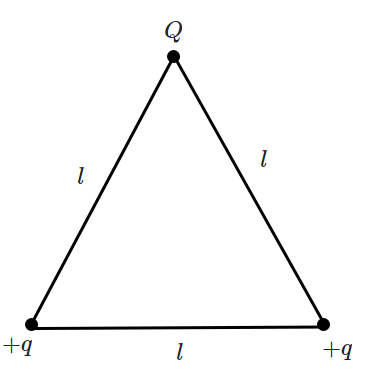On rotating a point charge having a charge \(q\) around a charge \(Q\) in a circle of radius \(r\), the work done will be:
1.
\(q \times2 \pi r\)
2.
\(q \times2 \pi Q \over r\)
3.
zero
4.
\(Q \over 2\varepsilon_0r\)
In the figure the charge \(Q\) is at the centre of the circle. Work done by the conservative force is maximum when another charge is taken from point \(P\) to:
| 1. | K | 2. | L |
| 3. | M | 4. | N |
What is the potential energy of two equal positive point charges of \(1~ \mu \text{C}\) each held \(1\) m apart in the air?
| 1. | \(9 \times 10^{-3}~\text{J}\) | 2. | \(9 \times 10^{-3}~\text{eV}\) |
| 3. | \(2~\text{eV/m}\) | 4. | zero |
| 1. | \(V \neq 0 \text { and } \vec{E} \neq 0\) |
| 2. | \(V \neq 0 \text { and } \vec{E}=0\) |
| 3. | \(V=0 \text { and } \vec{E}=0\) |
| 4. | \(V=0 \text { and } \vec{E} \neq 0\) |
| 1. | Electric potential at the surface of the cube is zero. |
| 2. | Electric potential within the cube is zero. |
| 3. | Electric field is normal to the surface of the cube. |
| 4. | Electric field varies within the cube. |
Three charges \(Q\), \(+q \) and \(+q \) are placed at the vertices of an equilateral triangle of side \(l\) as shown in the figure. If the net electrostatic energy of the system is zero, then \(Q\) is equal to:
| 1. | \(-\frac{q}{2} \) | 2. | \(-q\) |
| 3. | \(+q\) | 4. | \(\text{zero}\) |
A thin spherical conducting shell of radius \(R\) has a charge \(q\). Another charge \(Q\) is placed at the centre of the shell. The electrostatic potential at a point \(P\) which is at a distance \(\frac{R}{2}\) from the centre of the shell is:
1. \(\frac{\left( q + Q \right)}{4 \pi \varepsilon_{0}} \frac{2}{R}\)
2. \(\frac{2 Q}{4 \pi \varepsilon_{0} R}\)
3. \(\frac{2 Q}{4 \pi \varepsilon_{0} R} - \frac{2 q}{4 \pi \varepsilon_{0} R}\)
4. \(\frac{2 Q}{4 \pi \varepsilon_{0} R} + \frac{q}{4 \pi \varepsilon_{0} R}\)
A charge of \(10\) e.s.u. is placed at a distance of \(2\) cm from a charge of \(40\) e.s.u. and \(4\) cm from another charge of \(20\) e.s.u. The potential energy of the charge \(10\) e.s.u. is: (in ergs)
| 1. | \(87.5\) | 2. | \(112.5\) |
| 3. | \(150\) | 4. | \(250\) |
In a certain charge distribution, all points having zero potential can be joined by a circle \(S\). Points inside \(S\) have positive potential, and points outside \(S\) have a negative potential. A positive charge, which is free to move, is placed inside \(S\). What is the correct statement about \(S\):
| 1. | It will remain in equilibrium | 2. | It can move inside \(S\), but it cannot cross \(S\) |
| 3. | It must cross \(S\) at some time | 4. | It may move, but will ultimately return to its starting point |
Two charges \(q_1\) and \(q_2\) are placed \(30\) cm apart, as shown in the figure. A third charge \(q_3\) is moved along the arc of a circle of radius \(40\) cm from \(C\) to \(D\). The change in the potential energy of the system is \(\frac{q_{3}}{4 \pi \varepsilon_{0}} k\), where \(k\) is:

| 1. | \(8q_2\) | 2. | \(8q_1\) |
| 3 | \(6q_2\) | 4. | \(6q_1\) |




